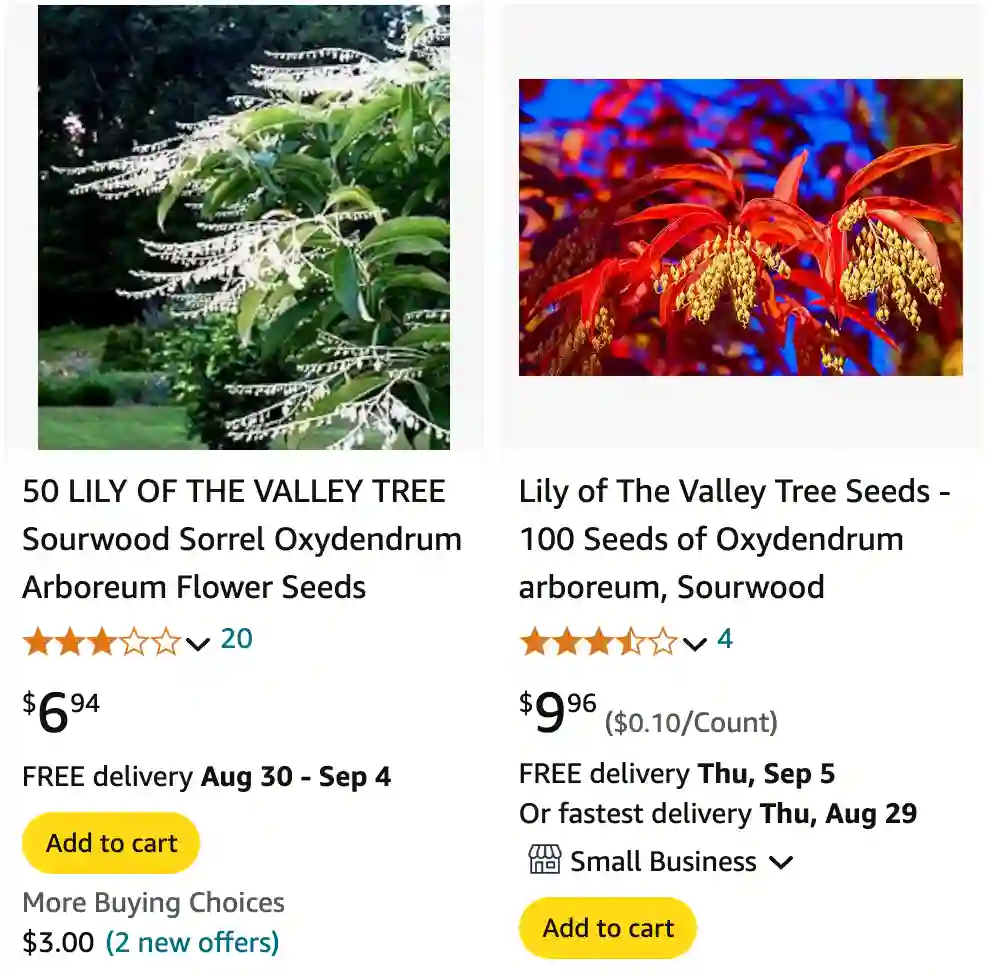
What Is Sourwood?
Sourwood, or Oxydendrum Arboreum, belong to the Ericaceae family, is a captivating deciduous tree native to the eastern United States. Known for its striking foliage and unique blossoms, it stands out in any landscape. I first came across Sourwood during a hike through a forest, and I was immediately drawn to its beauty and distinct characteristics.
Plant Family: 121 Genera in Ericaceae
What Does a Sourwood Tree Look Like?
The Sourwood tree is a medium-sized tree that typically grows to a height of 30 to 50 feet. Its leaves are one of its most distinctive features. They are elliptical with a slightly wavy margin and turn a brilliant red in the fall, making it a favorite for autumn landscapes. In the summer, the leaves are a rich green with a sour taste, which is where the tree gets its name. The bark is gray and furrowed, adding to the tree’s textured appearance.
When Do Sourwood Trees Bloom?
Sourwood trees bloom in mid to late summer, usually between June and July. The blossoms are small, white to pinkish, and appear in drooping clusters, known as panicles. These flowers are not only beautiful but also highly attractive to pollinators like bees and butterflies. The bloom period is relatively short but creates a stunning visual display and contributes to the tree’s overall charm.
Where Do Sourwood Trees Grow?
Sourwood trees thrive in the southeastern United States, particularly in the Appalachian region. They prefer well-drained, acidic soils and can often be found growing in forests or along woodland edges. They are quite adaptable and can tolerate a range of soil types, but they do best in areas with adequate moisture and some shade.
How Fast Do Sourwood Trees Grow?
Sourwood trees are relatively slow-growing compared to other species. They typically add about 12 to 24 inches of height per year. While this growth rate may seem modest, it’s worth the wait for their mature beauty. Over time, their slow growth contributes to their sturdy and robust structure.
Is Sourwood Good Firewood?
Yes, Sourwood is considered excellent firewood. It burns hot and clean, producing a pleasant aroma that many find appealing. The wood is dense and has a high heat value, making it a great choice for burning in stoves or fireplaces. Additionally, it produces minimal smoke and ash, which is a significant advantage for those who value a clean-burning fire.
Sourwood vs Wildflower Honey
Sourwood honey is highly prized for its unique flavor profile, which is derived from the nectar of the Sourwood tree’s blossoms. It has a distinct, mild, and slightly tangy taste. In contrast, wildflower honey comes from a variety of different flowers and tends to have a more complex and varied flavor, depending on the flowers present in the region where it is harvested. Sourwood honey’s unique characteristics make it a favorite among honey connoisseurs.
Sourwood vs Black Cherry
When comparing Sourwood to Black Cherry, there are notable differences. Black Cherry (Prunus serotina) is a larger tree that produces edible fruits and has a dark, almost black bark. Sourwood, on the other hand, is valued for its beautiful fall foliage and distinctive flowers. In terms of wood, Sourwood is often preferred for its superior burning qualities, whereas Black Cherry wood is sought after for its rich color and use in fine furniture.
Sourwood vs Clover Honey
Sourwood honey and clover honey are both popular types of honey but differ significantly in flavor and source. Clover honey, produced from the nectar of clover flowers, is light and sweet with a mild flavor. Sourwood honey has a richer, more complex flavor with a hint of tanginess. Both have their own unique qualities, but Sourwood honey’s distinct taste sets it apart.
Sourwood vs Persimmon
Sourwood and persimmon trees are quite different in terms of appearance and use. Persimmon (Diospyros virginiana) produces edible fruit and has a distinctive bark and foliage. In contrast, Sourwood is primarily valued for its ornamental qualities and the honey produced from its blooms. The two trees serve different purposes in landscaping and are not directly comparable.
Sourwood vs Tupelo Honey
Sourwood and tupelo honey each have their own unique flavors. Tupelo honey, harvested from the nectar of tupelo trees, is known for its light color and floral sweetness. Sourwood honey has a more robust and tangy flavor, reflecting the unique characteristics of the Sourwood tree’s blossoms. Both types of honey are highly prized, but their flavors cater to different preferences.
How to Care for a Sourwood Tree
Caring for a Sourwood tree involves ensuring it has the right soil conditions and adequate moisture. It’s essential to plant it in well-drained, acidic soil and provide regular watering, especially during dry periods. Sourwood trees are relatively low-maintenance but benefit from occasional pruning to maintain their shape and remove any dead or diseased branches.
How to Propagate Sourwood Trees
Sourwood trees can be propagated through seeds or cuttings. Seeds should be stratified (cold-treated) before planting to improve germination rates. For cuttings, it’s best to take them in late summer and use rooting hormone to encourage growth. Propagation can be challenging, so patience and attention to detail are key.
What to Plant With Sourwood Trees
Sourwood trees pair well with other native plants that thrive in similar conditions. Consider planting them alongside native ferns, rhododendrons, or mountain laurel to create a harmonious and attractive landscape. Their fall color contrasts beautifully with evergreen plants, adding visual interest to your garden.
Can You Grow Sourwood Indoors?
Growing Sourwood trees indoors is not ideal due to their size and specific growing requirements. They need plenty of space, sunlight, and access to outdoor conditions that are challenging to replicate indoors. For those interested in indoor gardening, smaller, more adaptable plants might be a better fit.
Is Sourwood Toxic?
Sourwood trees are not considered toxic to humans or animals. However, as with any plant, it’s wise to keep an eye on young children and pets to ensure they do not ingest any plant parts, just to be safe.
Benefits of Sourwood Trees
Sourwood trees offer several benefits, including their beautiful foliage, attractive blooms, and high-quality honey production. They also provide habitat and food for local wildlife, making them a valuable addition to any garden or landscape.
Common Problems with Sourwood Trees
While generally hardy, Sourwood trees can face issues such as leaf spot diseases and aphid infestations. Regular inspection and proper care can help mitigate these problems. Ensuring good air circulation and avoiding overhead watering can also reduce the risk of disease.
In summary, the Sourwood tree is a remarkable and versatile addition to any garden. Its unique characteristics, from its beautiful blossoms to its valuable honey, make it a worthwhile choice for anyone interested in enhancing their landscape.
If i die, water my plants!



